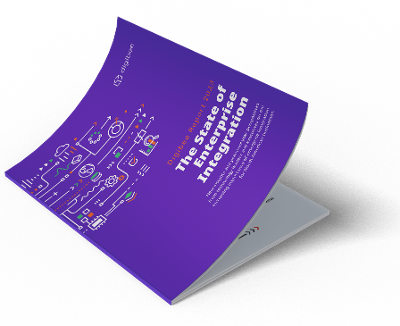April 25, 2023
Nossas segunda pesquisa anual do mercado de integração corporativa foi publicado hoje, revelando alguns insights intrigantes e gerando muita discussão.
Ao revisar os resultados da pesquisa, fiquei impressionado com uma constante. A maioria das organizações agora considera a integração um requisito fundamental para suas iniciativas de transformação digital. Na verdade, juntamente com a migração para a nuvem (um facilitador crítico na maioria dos projetos de modernização), a transformação digital é o principal objetivo de integração na pesquisa, com quase 30% dos entrevistados classificando-a como número um.
Este é um resultado surpreendente, especialmente quando você considera que apenas alguns anos atrás, a maioria das empresas ainda estava em dúvida sobre a implementação da tecnologia iPaaS.
Inspiração via Integração
Eu e os membros da equipe frequentemente discutimos com muitos líderes de diretoria, TI e AppDev. Durante essas conversas, descobrimos que muitos têm pelo menos um projeto de transformação digital em andamento – mas a maioria tem muitos. Embora a maioria destes projetos sejam relativamente simples, a motivação subjacente para alguns foi verdadeiramente inspiradora.
Então, ao invés de escrever um post de blog sobre o Relatório do estado de integração Digibee 2023 Com base nas descobertas, gostaríamos de compartilhar algumas das histórias inspiradoras e únicas por trás da transformação digital e as inúmeras razões pelas quais as pessoas implementam iPaaS para melhorar seus negócios.
Ajudar pessoas que precisam de ajuda
Objetivo da transformação digital: Garantir que todos os funcionários tenham acesso aos sistemas e dados necessários para apoiar as pessoas necessitadas.
Recentemente, um dos membros da nossa equipe conversou com o CIO de um condado com uma população de vários milhões de pessoas. O condado enfatiza a inovação como meio de oferecer suporte de alta qualidade às pessoas que atende, priorizando o respeito e a integridade em todas as suas interações.
Por exemplo, se uma pessoa com problemas de saúde mental ou moradia precisar de assistência, o condado deseja garantir que o funcionário seja capaz de fornecer toda a gama de serviços disponíveis para o indivíduo. Isso pode incluir acesso a suporte médico ou psicológico, abrigo, roupas, alimentação, telefones celulares pré-pagos e outras necessidades.
Infelizmente, esta não é uma tarefa simples. Impedidos por aplicativos herdados autônomos, sistemas de terceiros de outras agências (judiciário, médico, etc.) e dados isolados, a maioria dos funcionários municipais só consegue acessar um subconjunto dos dados de que precisam para oferecer uma experiência de serviço completa. Em vez disso, eles devem navegar em uma infraestrutura que é remendada com codificação personalizada ou nenhuma codificação – geralmente exigindo papelada manual e demorada.
Reconhecendo como o sistema está falhando, os líderes da organização decidiram integrar toda a infraestrutura de TI do condado, permitindo que qualquer funcionário acesse facilmente todas as informações necessárias para atender a comunidade de maneira otimizada.
Esta foi uma discussão inspiradora. Embora a infra-estrutura recentemente ligada também proporcione eficiências significativas em termos de tempo e custos e uma série de outros benefícios empresariais, ficou claro que a verdadeira motivação era ajudar as pessoas — funcionários públicos e residentes do condado — nos seus momentos de necessidade.
Capacitar as pessoas para serem campeãs de serviço
Objetivo da transformação digital: Forneça aos funcionários os dados de que precisam para trabalhar de forma independente, proporcionando excelentes experiências aos clientes na primeira vez, sempre.
Nossa equipe também interagiu com um líder de uma rede de supermercados da costa leste que está em fase de expansão. O supermercado é conhecido por suas lojas exclusivas e seu foco inabalável em oferecer uma excelente experiência ao cliente (CX).
Reconhecendo que as melhores pessoas para otimizar o CX são aquelas que interagem diretamente com os clientes, a empresa inicia um projeto de transformação digital. Evitando uma cadeia formal de modelo de gerenciamento de comando, a iniciativa capacita os funcionários a fazerem as coisas que acreditam que precisam fazer, no momento, para ajudar os clientes.
Isso requer a integração de aplicativos e dados em uma infraestrutura complexa composta por mais de 100 sistemas diferentes, do mainframe ao moderno. O objetivo do projeto é criar uma infraestrutura combinável e conectada – essencialmente um hub, onde os dados são facilmente compartilhados internamente sem movê-los.
“O valor está no ponto de integração.”
– VP, Desenvolvimento de Aplicativos, Rede Regional de Supermercados
O novo modelo nega a necessidade de lidar ativamente com os dados, por exemplo, extrair, transformar, carregar (ETL) e outras transações de dados em massa que levam tempo enquanto aumentam os riscos de segurança e o potencial de erro humano. Em vez disso, o supermercado terá maior visibilidade e acesso a dados em tempo real em vários sistemas.
Obviamente, o novo sistema fornecerá à organização uma série de benefícios que vão além de um CX otimizado, incluindo análise de dados em tempo real para ajudar a orientar as decisões de negócios do dia-a-dia. Mas ficou claro na discussão que o aspecto mais importante do projeto – a estrela do norte – é apoiar e capacitar as pessoas que trabalham lá para oferecer sempre a melhor experiência ao cliente.
A próxima grande ideia
As histórias de transformação digital são infinitas e continuarão a evoluir, inspiradas pela criatividade humana e possibilitadas pela tecnologia. Com base no feedback da pesquisa de líderes do setor, a integração tornou-se um componente essencial para alcançar nossas grandes ideias, hoje e no futuro.
 Baixe uma cópia do relatório Digibee 2023 State of Enterprise Integration para obter a história completa, incluindo como o iPaaS está ajudando as organizações a alcançar suas iniciativas de transformação digital.
Baixe uma cópia do relatório Digibee 2023 State of Enterprise Integration para obter a história completa, incluindo como o iPaaS está ajudando as organizações a alcançar suas iniciativas de transformação digital.
Se você tem uma história de integração para compartilhar ou está no meio de um projeto e deseja discuti-lo, entre em contato conosco. Para mais informações sobre a Digibee, agende uma demonstração.








